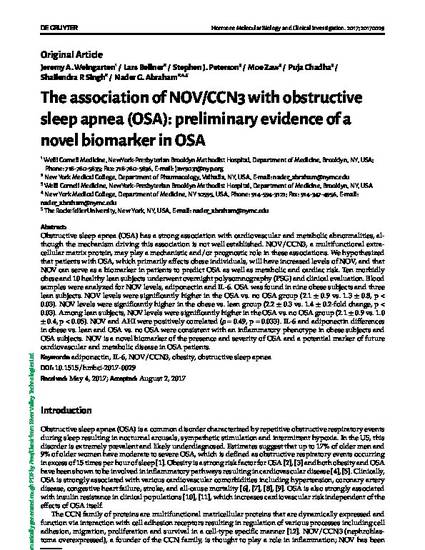
Obstructive sleep apnea (OSA) has a strong association with cardiovascular and metabolic abnormalities, although the mechanism driving this association is not well established. NOV/CCN3, a multifunctional extracellular matrix protein, may play a mechanistic and/or prognostic role in these associations. We hypothesized that patients with OSA, which primarily affects obese individuals, will have increased levels of NOV, and that NOV can serve as a biomarker in patients to predict OSA as well as metabolic and cardiac risk. Ten morbidly obese and 10 healthy lean subjects underwent overnight polysomnography (PSG) and clinical evaluation. Blood samples were analyzed for NOV levels, adiponectin and IL-6. OSA was found in nine obese subjects and three lean subjects. NOV levels were significantly higher in the OSA vs. no OSA group (2.1 +/- 0.9 vs. 1.3 +/- 0.8, p < 0.03). NOV levels were significantly higher in the obese vs. lean group (2.2 +/- 0.3 vs. 1.4 +/- 0.2-fold change, p < 0.03). Among lean subjects, NOV levels were significantly higher in the OSA vs. no OSA group (2.1 +/- 0.9 vs. 1.0 +/- 0.4, p < 0.05). NOV and AHI were positively correlated (rho = 0.49, p = 0.033). IL-6 and adiponectin differences in obese vs. lean and OSA vs. no OSA were consistent with an inflammatory phenotype in obese subjects and OSA subjects. NOV is a novel biomarker of the presence and severity of OSA and a potential marker of future cardiovascular and metabolic disease in OSA patients.
Available at: http://works.bepress.com/nader_abraham/63/
